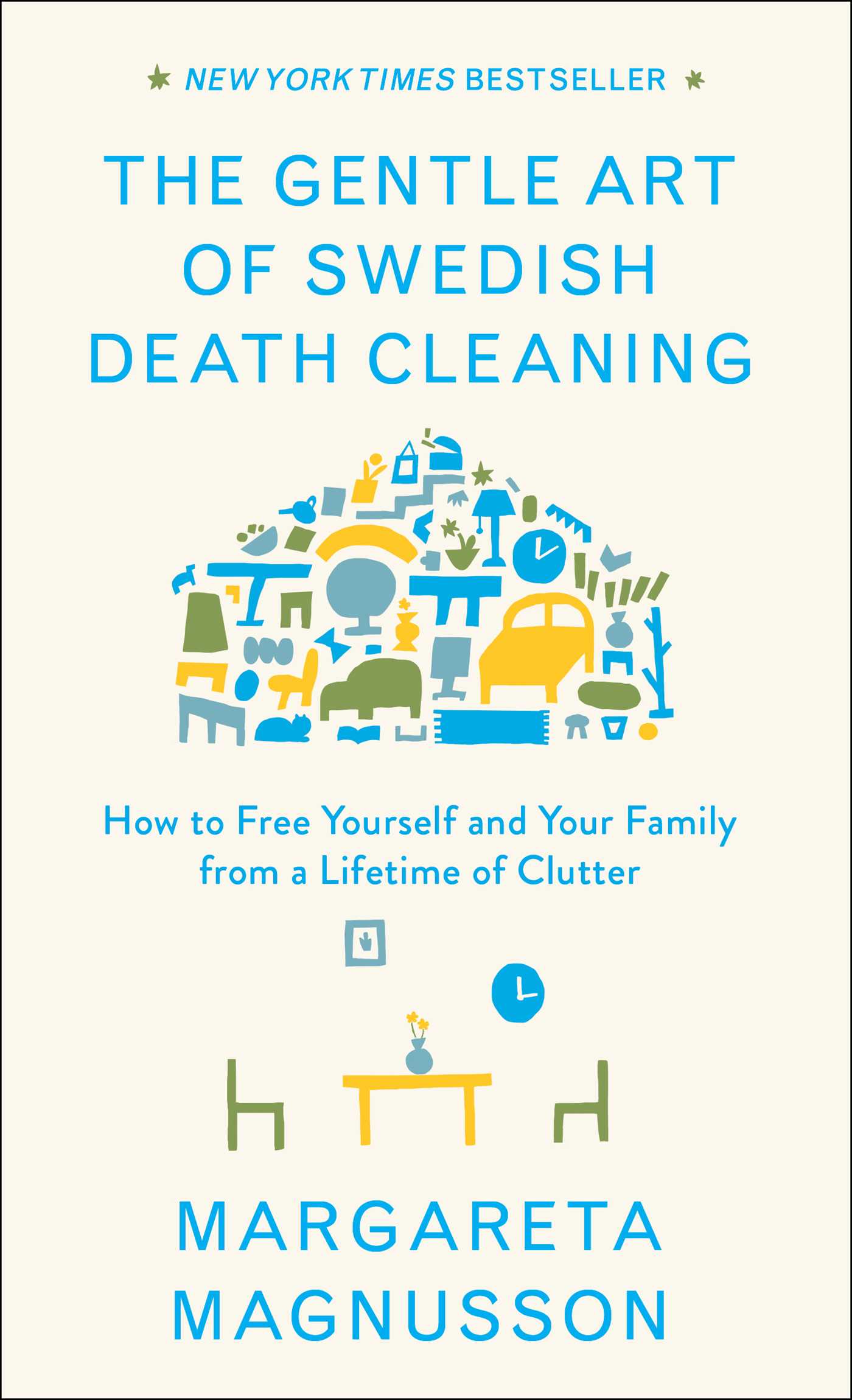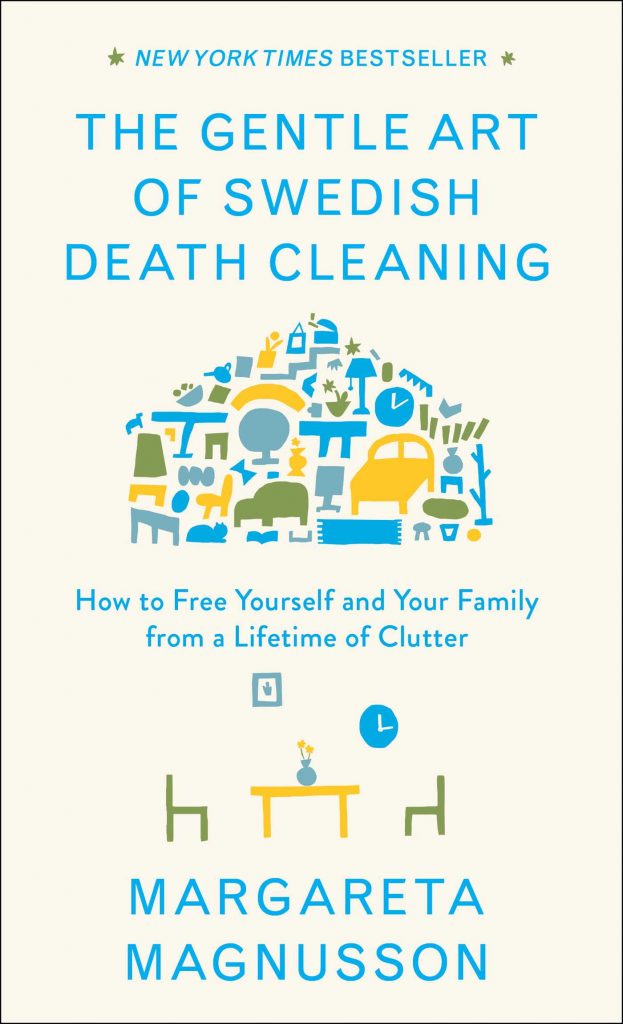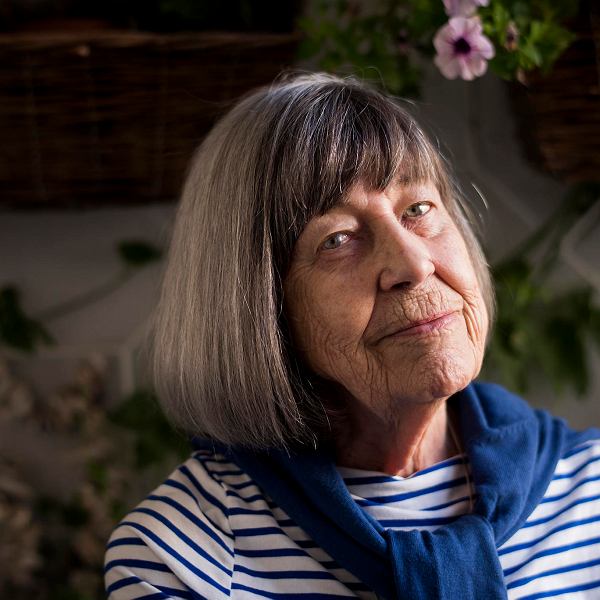The Gentle Art of Swedish Death Cleaning Summary

9 min read ⌚

How to Free Yourself and Your Family from a Lifetime of Clutter
Marie Kondo made tidying up not only a fashionable habit but also a life-changing one.
Margareta Magnusson is here to offer some tips and tricks from the practices in her own home country.
Ladies and gentlemen, time to learn a little something about:
The Gentle Art of Swedish Death Cleaning.
Who Should Read “The Gentle Art of Swedish Death Cleaning”? And Why?
If you are a hoarder who wants to change his/her lifestyle as soon as possible, The Gentle Art of Swedish Death Cleaning may be the first book you need to read – and straight away, if you ask us!
The same holds true for anyone who doesn’t know what decluttering is, and has a problem finding space in his/her apartment for his new piece of clothing, or even a pencil.
Also, if you enjoy watching Marie Kondo YouTube tutorials and reading her books (The Life-Changing Magic of Tidying Up and Spark Joy), there’s no reason not to enjoy Margareta Magnusson’s debut – their books may have a different starting point, but essentially they do have the same message.
And for all their differences, it’s only natural once you finish Tolstoy, to read Dostoyevsky, isn’t?
About Margareta Magnusson

Margareta Magnusson is a Swedish Stockholm-based author and artist, dubbed by at least one author “the Marie Kondo of death.”
Not younger than 80 years nor older than a 100 (she is shy about her age), Magnusson is a graduate of Beckman College School of Design and has had her work exhibited in many galleries around the world, most notably in Singapore and Hong Kong.
Published in2018, The Gentle Art of Swedish Death Cleaning is her debut book; it became a New York Times bestseller and quickly rose to the top of many “best of” lists of 2018.
“The Gentle Art of Swedish Death Cleaning PDF Summary”
“Part guidebook on how to how to declutter your home, part meditation on coming to terms with aging and how to make the process of downsizing less painful,” The Gentle Art of Swedish Death Cleaning is precisely what you’d expect from a book with such a title.
“The only thing we know for sure,” writes Magnusson in the very first sentence of the book, “is that one day we will die. But before that, we can do anything.”
Apparently, one of the most important things one can and should do is decluttering his/her house.
Because, as our favorite modern lyricist Leonard Cohen says (quoted by Magnusson): “Putting your house in order, if you can do it, is one of the most comforting activities, and the benefits of it are incalculable.”
So, let’s see what this means in practice and how tidying up your home can be – or even is – related to death.
Döständning, or One Last Sweep Before You Die
Let’s start with an inevitable fact: one day you’ll die, and you’ll leave a lot of items behind you. Have you ever thought about what will happen to them once you’re gone?
As it should be only obvious, your loved ones will one day have to go through them. You can guess the results: they’ll throw away some of them, they’ll keep others, they’ll try to decide who deserves what of the most valuable ones.
This process is both physically and psychologically taxing; in many cases, no wonder that, in many cases, it can result in acrimonious disputes.
Take, for example, Margareta herself.
On her deathbed, her mother left her a charming bracelet. However, unlike her mother, Margareta has five children, so she knew full well that no matter what her choice would be on who to inherit it, that bracelet will probably cause much more sadness and bitterness than joy and laugher.
Her solution?
She simply sold the bracelet; as valuable as it was (of course, emotionally much more than financially), it wasn’t nearly as valuable as family bliss.
The selling of the bracelet was part of Margareta’s döständning, Swedish for “death cleaning,” or, as we would like to say “one last sweep before you die.”
It may sound strange, but it is a fact of life in the Scandinavian countries.
Just like it is a great idea to clean your house before you leave on vacation (so that you are not shocked once you come back), the Scandinavians believe that it is an even better one – nay, a duty! – to comb through all of your belongings and throw away the unnecessary stuff before you live this planet.
After all, who knows them better than you? And why should you bother others with your useless items?
Decluttering Is Bonding – If You Do It Right
In other words, if you care for your loved ones, then it’s only fair to spare them the emotional and physical burden of cleaning up your stuff.
Start with your attic or basement (depending on which one of the two you have) and with the big items: furniture, books, items that take up a lot of space…
It’s not that you can’t start with the small items in that secret box under your bed, but let’s face it – it will take you forever to make any progress if you do that.
Not that it’s easy to get rid of your old dollhouses or twice-used sports equipment!
After all, these items will remind you of your happy childhood days just as you’re nearing to your death; and, as we learned from Citizen Kane, nothing can be more poignant and heartbreaking than that!
However, think of the problems your books or toys may cause between your loved ones once you are gone; and should we remind you that you won’t be there to mend them?
So, ask yourself for each item: will you ever need this again? Will someone else need it?
Granted, as tricky as it is, the first question may be a bit easier to answer than the latter one.
Magnusson has a solution for that: if you don’t know if something will be useful to some of your loved ones, well, call them and ask them!
While you’re alive.
There, now you’ve created a great opportunity for the family to bond!
Because not many of them will know everything about the younger “you,” and some of them – like your grandchildren, for example – will probably discover a completely new “you.”
Nothing bonds as much as a walk down memory lane.
Here’s your chance to walk it – while you declutter!
Döständning and Being Discreet
As you’ve probably guessed, it’s a bit dangerous to invite your loved ones over to help you declutter if some of the things you’ve kept throughout the years, you’ve kept hidden from them for a reason.
Take a page out of Margareta Magnusson’s book.
After the death of her parents, she was death cleaning their house and found a few unusual items; for example, secret cartons of cigarettes hidden in a linen closet.
Apparently, her mother was smoking in private – something she didn’t want anyone to know or find out. Margareta included: she realized that she might have been happier if she had never found about her mother’s vice.
More mysterious and even scarier, in her father’s desk, Margareta discovered a large piece of arsenic dating from at least three decades before her father’s death.
Since her father passed away in the 1970s, it was evident to Margareta that the arsenic was acquired when her parents had feared that Sweden might be invaded by the Germans.
However, why did it remain in the cabinet for so long? Did her father – or even her parents – had another secret that Margareta would probably never find out?
Once again, do you really like your children and their children to wonder about things such as these once you’re not alive to offer an explanation?
So, be very careful before you start inviting your relatives and gifting them your memories. Some of your memories are not supposed to be given away.
Yes, that is especially true for your diaries and your love letters!
Read them carefully and see if there’s anything in there you don’t want anyone to find out.
If so, ask yourself whether it’s smart to keep them still.
That’s right:
Time to throw them away or, better yet, burn them!
The Throw-Away Box and the Cabinet for the Ugly
Now, Margareta knows that it’d be almost impossible for you to get rid of things as personal as diaries, letters or photographs.
If that’s the case, Margareta suggests putting them in an easily disposable “throw-away box,” adorned with a sticker: “please throw away this without opening it.”
This should certainly help since it bereaves you of the burden of throwing away something you cherish in addition to relieving you from your doubts that these things will eventually be seen by someone else after your death.
But, let’s face it: there’s no guarantee about the latter.
If you don’t believe us, just ask Franz Kafka!
So, we suggest the strategy above: when you are confident that something of yours should be seen by nobody other than yourself, make sure that you are the last person who’ll ever see it.
On the subject of throw-away containers – Magnusson mentions another type:
I do know people who maintain what we in Sweden call a fulskåp, a cabinet for the ugly. A fulskåp is a cupboard full of gifts you can’t stand to look at, and which are impossible to regift. Usually these are presents from distant aunts and uncles that you put on display when the giver comes to visit.
You don’t need Magnusson to tell you that “this is a bad idea.” It both occupies space and inspires others to give you similar gifts.
If those gifts are not who you are – be honest.
If you’re a girl and you vax, you know what we’re talking about: the rip of the Band-Aid hurts like hell, but everything’s both better and cleaner soon after.
Key Lessons from “The Gentle Art of Swedish Death Cleaning”
1.
Decluttering: A Lesson from the Vikings
2. Swedish Death Cleaning: The Art
You Should Master
3. Decluttering and the Two
Questions You Should Ask About Each Item You Own
Decluttering: A Lesson from the Vikings
Once you die, you leave behind many of your items on this planet. Of course, these become a responsibility of your loved ones: they need to clean your stuff up.
That’s not very fair on your part if you ask Margareta Magnusson.
So, take a page out of the book of the Vikings: when they died, they were buried (or cremated) together with their belongings.
This way, the Vikings believed, they wouldn’t miss their favorite items in Valhalla; but also – speaking in more practical manners – this way the surviving loved ones wouldn’t have to quarrel over who should own them.
For example, in Greek mythology, Ajax went mad and killed himself after Odysseus got Achilles’ armor soon after Achilles was killed.
Yup, that’s a very cruel, but also good, metaphor for the problems your bracelet may cause once you die – if, say, you have more than one daughter.
Swedish Death Cleaning: The Art You Should Master
There’s a better way to tackle this problem.
It’s called döständning in Swedish, a word which can be translated as “death cleaning” in English.
And it means exactly what you think it means: getting rid of the stuff you don’t need so that your surviving loved ones don’t have to once you leave this planet.
It’s not only good manners – but it’s also a great way to spare your loved ones the psychological burden of painful memories even long after you’re gone.
“Let me help make your loved ones’ memories of you nice,” says Magnusson at one place, “instead of awful.”
Decluttering and the Two Questions You Should Ask About Each Item You Own
An excellent way to decide whether an item should be thrown away or kept is by asking two questions about it.
The first one is the obvious one: “Will I ever need this?”
The second one becomes more important with every day you’re nearing to your death “Will anyone I know be happier if I save this?”
If you don’t know the answer to the second question, invite your loved ones and ask them in person. Thus, decluttering becomes a great way to bond with them.
However, don’t ever forget:
You can always hope and wait for someone to want something in your home, but you cannot wait forever, and sometimes you must just give cherished things away with the wish that they end up with someone who will create new memories of their own.
Like this summary? We’d like to invite you to download our free 12 min app for more amazing summaries and audiobooks.
“The Gentle Art of Swedish Death Cleaning Quotes”
Start with the large items in your home, and finish with the small. Share on X I often ask myself: ‘will anyone I know be happier if I save this?’ Share on X The one thing we know for sure is that we will die one day. But before that you can try to do almost anything. Share on X You really can't take everything with you, so maybe it is better to not try to own it all. Share on X It is amazing, and also a little strange, how many things we accumulate in a lifetime. Share on XOur Critical Review
Before The Gentle Art of Swedish Death Cleaning, we didn’t even know that there was such a thing as “death cleaning.” Now, it’s suddenly all we think about.
“A fond and wise little book,” writes Dwight Garner for The New York Times. “I jettison advice books after I’ve flipped through them. This one I will keep.”
We too, Dwight. This one’s a great, great, great book.








